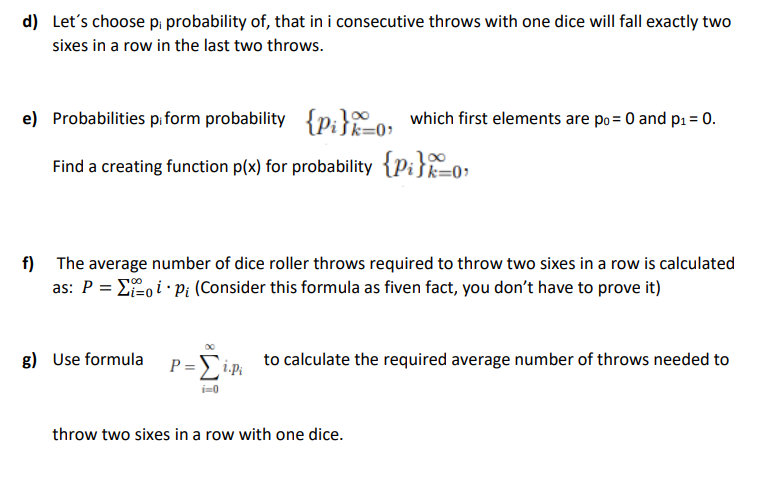Calculate the average number of rolls of one dice needed to roll two sixes in a row.
Elementary Geometry For College Students, 7e
7th Edition
ISBN:9781337614085
Author:Alexander, Daniel C.; Koeberlein, Geralyn M.
Publisher:Alexander, Daniel C.; Koeberlein, Geralyn M.
Chapter8: Areas Of Polygons And Circles
Section8.1: Area And Initial Postulates
Problem 3E: Consider the information in Exercise 2, but suppose you know that the area of the region defined by...
Related questions
Question
![Calculate the average number of rolls of one dice needed to roll two sixes in a row.
Instructions on how to proceed:
a) The assignment means that we will roll the dice until two sixes fall in a row. The number of
throws we've made is the number of throws needed to roll two sixes in a row. Your task is
to calculate the average number of rolls of one dice needed to roll two sixes in a row. We
get the average number by repeating the given experiment an infinite number of times and
calculating the average of the achieved results
b) Let's mark a; the probability that in i one consecutive roll does not fall twice 6 in a row and
six fall in the last roll.
Let bi denote the probability that one dice will not fall in even consecutive rolls six in a row
and six in the last roll will not fall.
[still b) but maybe better translated:
Let us also mark the probability that he will not fall by one dice in even consecutive throws
twice in a row and six in the last roll.
Let's mark the probability that one dice will not fall in one successive throw
six in a row and six in the last roll]
c) Probabilities a; , b; form sequences {a;}=o and {b;}=0-
Their first members are a, = 0 and bo = 1.
Assemble a set of recurring relationships for sequences {a;}%=0 and {b;}%-0 and find the
creating functions ax) and b(x) for this sequences.
100](/v2/_next/image?url=https%3A%2F%2Fcontent.bartleby.com%2Fqna-images%2Fquestion%2F89a14718-b591-4a4c-9425-93adfa761720%2F0eadffaf-8268-4860-9c13-a4c0c9649ebc%2Fx26huz_processed.png&w=3840&q=75)
Transcribed Image Text:Calculate the average number of rolls of one dice needed to roll two sixes in a row.
Instructions on how to proceed:
a) The assignment means that we will roll the dice until two sixes fall in a row. The number of
throws we've made is the number of throws needed to roll two sixes in a row. Your task is
to calculate the average number of rolls of one dice needed to roll two sixes in a row. We
get the average number by repeating the given experiment an infinite number of times and
calculating the average of the achieved results
b) Let's mark a; the probability that in i one consecutive roll does not fall twice 6 in a row and
six fall in the last roll.
Let bi denote the probability that one dice will not fall in even consecutive rolls six in a row
and six in the last roll will not fall.
[still b) but maybe better translated:
Let us also mark the probability that he will not fall by one dice in even consecutive throws
twice in a row and six in the last roll.
Let's mark the probability that one dice will not fall in one successive throw
six in a row and six in the last roll]
c) Probabilities a; , b; form sequences {a;}=o and {b;}=0-
Their first members are a, = 0 and bo = 1.
Assemble a set of recurring relationships for sequences {a;}%=0 and {b;}%-0 and find the
creating functions ax) and b(x) for this sequences.
100

Transcribed Image Text:d) Let's choose p; probability of, that in i consecutive throws with one dice will fall exactly two
sixes in a row in the last two throws.
e) Probabilities pi form probability
{p;}o. which first elements are po= 0 and p1 = 0.
k=0?
Find a creating function p(x) for probability {Pi}o;
Šk=0•
f)
The average number of dice roller throws required to throw two sixes in a row is calculated
as: P = E, i Pi (Consider this formula as fiven fact, you don't have to prove it)
g) Use formula P=Sim to calculate the required average number of throws needed to
i=0
throw two sixes in a row with one dice.
Expert Solution
This question has been solved!
Explore an expertly crafted, step-by-step solution for a thorough understanding of key concepts.
This is a popular solution!
Trending now
This is a popular solution!
Step by step
Solved in 2 steps

Recommended textbooks for you

Elementary Geometry For College Students, 7e
Geometry
ISBN:
9781337614085
Author:
Alexander, Daniel C.; Koeberlein, Geralyn M.
Publisher:
Cengage,

Mathematics For Machine Technology
Advanced Math
ISBN:
9781337798310
Author:
Peterson, John.
Publisher:
Cengage Learning,

Holt Mcdougal Larson Pre-algebra: Student Edition…
Algebra
ISBN:
9780547587776
Author:
HOLT MCDOUGAL
Publisher:
HOLT MCDOUGAL

Elementary Geometry For College Students, 7e
Geometry
ISBN:
9781337614085
Author:
Alexander, Daniel C.; Koeberlein, Geralyn M.
Publisher:
Cengage,

Mathematics For Machine Technology
Advanced Math
ISBN:
9781337798310
Author:
Peterson, John.
Publisher:
Cengage Learning,

Holt Mcdougal Larson Pre-algebra: Student Edition…
Algebra
ISBN:
9780547587776
Author:
HOLT MCDOUGAL
Publisher:
HOLT MCDOUGAL

College Algebra (MindTap Course List)
Algebra
ISBN:
9781305652231
Author:
R. David Gustafson, Jeff Hughes
Publisher:
Cengage Learning